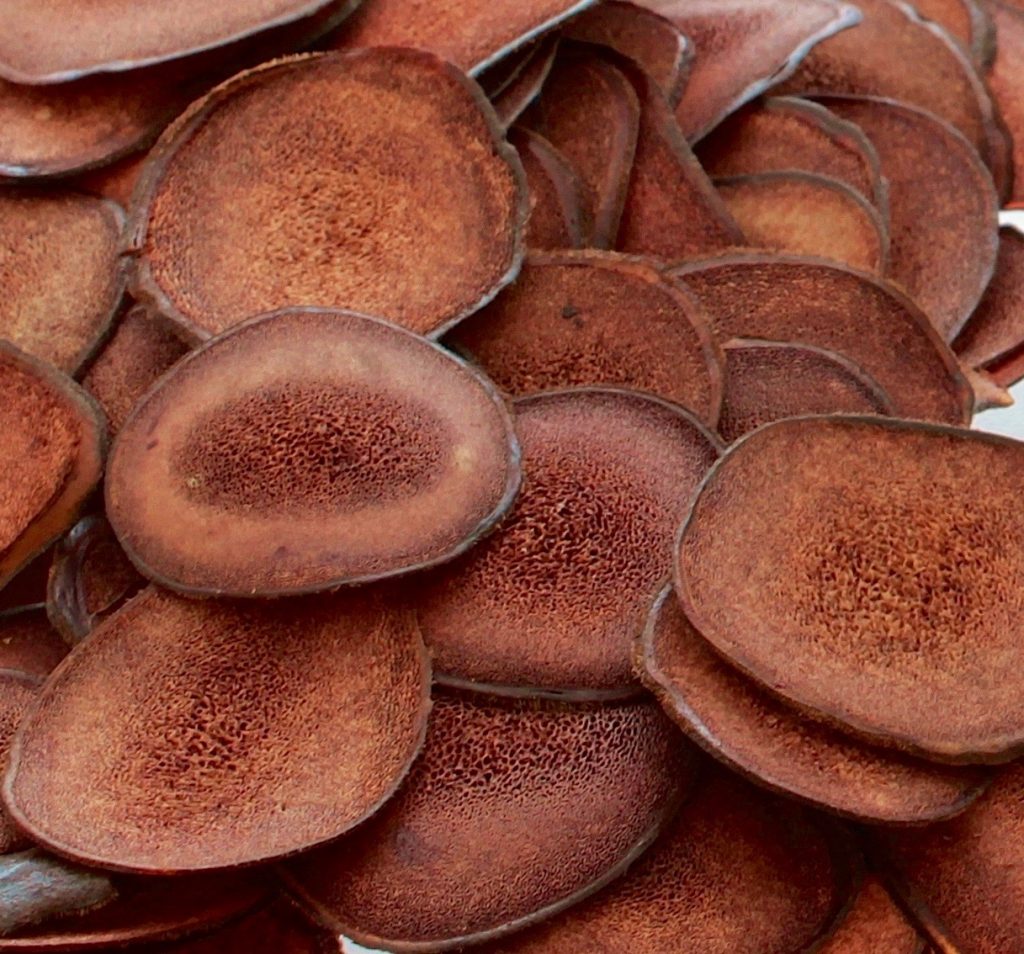“In this country when you see a tree, you know perfectly well it is not a tree; it’s the horns of a Caribou,” Ernest Thompson Seton wrote in The Arctic Prairies. This fitting remark notwithstanding, the deciduous crowns of Rangifer tarandus are properly “antlers,” after antoillier, Old French for “before the eye.”
Unlike horns, they drop yearly and like real trees thrive at the tips, not the base. During their last stage, they calcify into dead matter. Keratin, the stuff of hair and fingernails, armors a horn’s bone core, which stays alive.
Caribou sport the biggest antlers compared to body size and are the sole deer with both sexes thus equipped. A male’s recurved, wrist-thick brackets flare into NBA-star palms with dozens of stiletto digits. These wax more impressive throughout their owner’s life, ranking among the most prolific animal tissues—cell grafts caused other deer bones and even mouse foreheads to burgeon. The world-record barren-ground caribou is a Lake Iliamna 42-pointer whose left beam rises nearly five feet. A mature bull’s 35 gravity-defying pounds embody refinement: sculpted from the land’s fiber, shining like buffed mahogany, worshipped since cave art premiered. The twin trunks’ gestalt, described by Sumner MacLeish as “movement, caught and stilled,” can vary in any given year. Asymmetry crops up especially in the flat, vertical brow tine or “shovel” centered above the muzzle. A spike opposite normally matches it, so hunters love rare double-bladed trophies. These offshoots are neither ice picks nor snow shovels. They serve as visors against branches as bulls thresh bushes to beef up their necks, protecting eyes also in the rut’s showdowns.
New antlers
Replacement starts in March, at two bone-stump pedicles sprouting cartilage. Dun, chocolate-brown, or darker “velvet” sheathes the marrow in contrast with snowy chests. This fuzzy skin laced with nerves, scent glands, and arteries supplies calcium and phosphorus. High-volume blood flow in the enlarging tissue dissipates excess heat. “It is quite possible that the most beautiful antlers in the world are the antlers of a bull caribou in black velvet,” the writer Lois Crisler thought—Athabaskans ever practical roasted and peeled them for bacon crisps.
Before August ends, the spongy limbs harden, malformed if injured earlier. By September, itchy bulls stripping velvet mangle willows. Sparring with scrub, prepping for courtship with antlers stained crimson, they’re a sight: crazed, a tad ragged, festooned with gory pennants. Brilliant arsenal ready, they await autumn’s contests, jousting without putting much muscle into it yet while drifting south.

Antler use for people and caribou
The Palmer Reindeer Farm installs cut trees and street-sweeper’s brushes in season—exfoliating aids. Velvet-antler pulverized in sports supplements or Chinese folk remedies promises vigor at $10 an ounce. Between 1987 and 2003, western Alaska “Viagra” generated $10.3 million, important income for Seward Peninsula herders. Bleached cast-offs scattered in a herd’s wake furnish craft material wrinkled nicely with the beds of former sub-velvet capillaries. Eskimos differentiating 10 sections in a spread heat-bent or carved them into bows, blubber pounders, harpoon points, and, indeed, snow shovels.
To build one tenth of his body’s heft this fast, adding half an inch daily, a bull pilfers minerals from his skeleton. Ribs but not weight-bearing bones become brittle plywood slats. He’ll restore his strength with pre-rut feeding frenzies. In the cervid arms race, cranial grandeur signals health, seniority, dominance, the smarts to dodge predators, and the moxie to sire hale calves, all turn-ons for cows. Rack-wearing researchers hornswoggling females away from less endowed males proved this. As push comes to shove, the odd bleary-eyed bout sees both combatants starving to death, tines interlocked. Still, these are not purposely lethal duels, no gladiator spear fights, but arm-wrestling matches.
Caribou antlers in winter
Cumbersome weapons are discarded in November when bone-eating cells erode the basal burrs. “Sheds” gathering moss and showing vole, wolf, or fellow ungulates’ nibbles cycle nutrients via the creatures’ scat back into caribou forage. Come winter, non-pregnant cows surrender much shorter, slenderer, less ornate rigs. Weeks after their sore knobs have healed, budding resumes.
Young bucks keep their ossified pride through April. Expecting mothers, fully racked since September, wield theirs into June, besting rivals at snow cratered by hoof to reach lichen and later frustrating wolves trailing the nurseries. Like bulls, cows with the largest sets are high-ranking, fittest. Testosterone triggers pedicle growth, though some does don’t gear up at all; on poor pastures, baldies may outnumber crested caribous. Female antlers plateau with puberty around age three. The energy saved then flows into producing a fetus and milk.
Enter Rudolph and his stag party, prancing about in late December lavishly pronged. But, according to size charts and a shedding schedule that day length or “photoperiod” rules, shouldn’t Rudi be “Rosy?” Or “Reina?” Most sled-pulling reindeer, in fact, were and are geldings whose head timber and timing resembles that of females. Gentled, unmanned, they heed only Santa, never sidetracked by sex.


Comments are closed.